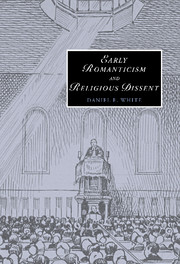Book contents
- Frontmatter
- Contents
- List of illustrations
- Acknowledgments
- Frequently cited texts
- Epigraph
- Introduction
- 1 “True Principles of Religion and Liberty”: liberal Dissent and the Warrington Academy
- 2 Anna Barbauld and devotional tastes: extempore, particular, experimental
- 3 The “Joineriana”: Barbauld, the Aikin family circle, and the Dissenting public sphere
- 4 Godwinian scenes and popular politics: Godwin, Wollstonecraft, and the legacies of Dissent
- 5 “Properer for a Sermon”: Coleridgean ministries
- 6 “A Saracenic mosque, not a Quaker meeting-house”: Southey's Thalaba, Islam, and religious nonconformity
- 7 Conclusion
- Notes
- Bibliography
- Index
- CAMBRIDGE STUDIES IN ROMANTICISM
3 - The “Joineriana”: Barbauld, the Aikin family circle, and the Dissenting public sphere
Published online by Cambridge University Press: 22 September 2009
- Frontmatter
- Contents
- List of illustrations
- Acknowledgments
- Frequently cited texts
- Epigraph
- Introduction
- 1 “True Principles of Religion and Liberty”: liberal Dissent and the Warrington Academy
- 2 Anna Barbauld and devotional tastes: extempore, particular, experimental
- 3 The “Joineriana”: Barbauld, the Aikin family circle, and the Dissenting public sphere
- 4 Godwinian scenes and popular politics: Godwin, Wollstonecraft, and the legacies of Dissent
- 5 “Properer for a Sermon”: Coleridgean ministries
- 6 “A Saracenic mosque, not a Quaker meeting-house”: Southey's Thalaba, Islam, and religious nonconformity
- 7 Conclusion
- Notes
- Bibliography
- Index
- CAMBRIDGE STUDIES IN ROMANTICISM
Summary
In 1775, two years after Miscellaneous Pieces in Prose, by J. and A. L. Aikin issued from the press of Joseph Johnson, Anna Barbauld wrote to her brother John, “I think we must some day sew all our fragments together, and make a Joineriana of them. Let me see: – I have, half a ballad; the first scene of a play; a plot of another, all but the catastrophe; half a dozen loose similies, and an eccentric flight or two among the fairies” (Works, ii, p. 9). In her use of the expression “Joineriana,” Anna implies to John that whereas their half-ballads, first scenes, loose similies, and eccentric flights might remain incomplete on their own, by “sewing” these fragments together the siblings could produce a presentable patchwork. Although this particular project never materialized, she continued to conceive of literary production according to a model of familial collaboration. Twelve years later, as Barbauld and her husband, Rochemont, were settling into their new home in Hampstead, she wrote to her brother, “We are making a catalogue of our books; and I have left a great deal of space under the letters A. and B. for our future publications” (Works, ii, p. 155). The growth of this catalogue accompanies Barbauld's organization of a new domestic setting in which she, her husband, and their adopted son Charles, the biological child of John and Martha Aikin, will live.
- Type
- Chapter
- Information
- Early Romanticism and Religious Dissent , pp. 66 - 86Publisher: Cambridge University PressPrint publication year: 2007



